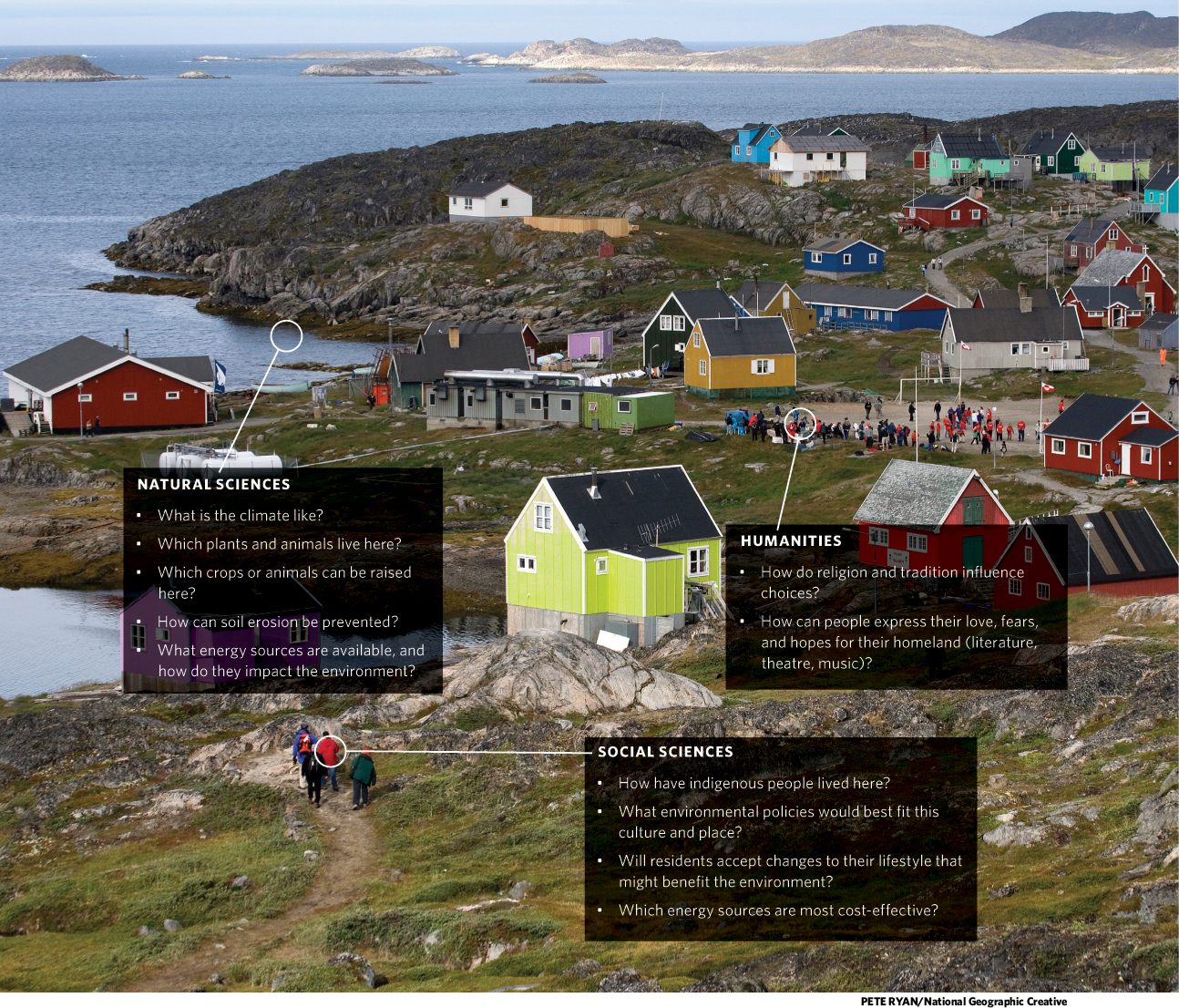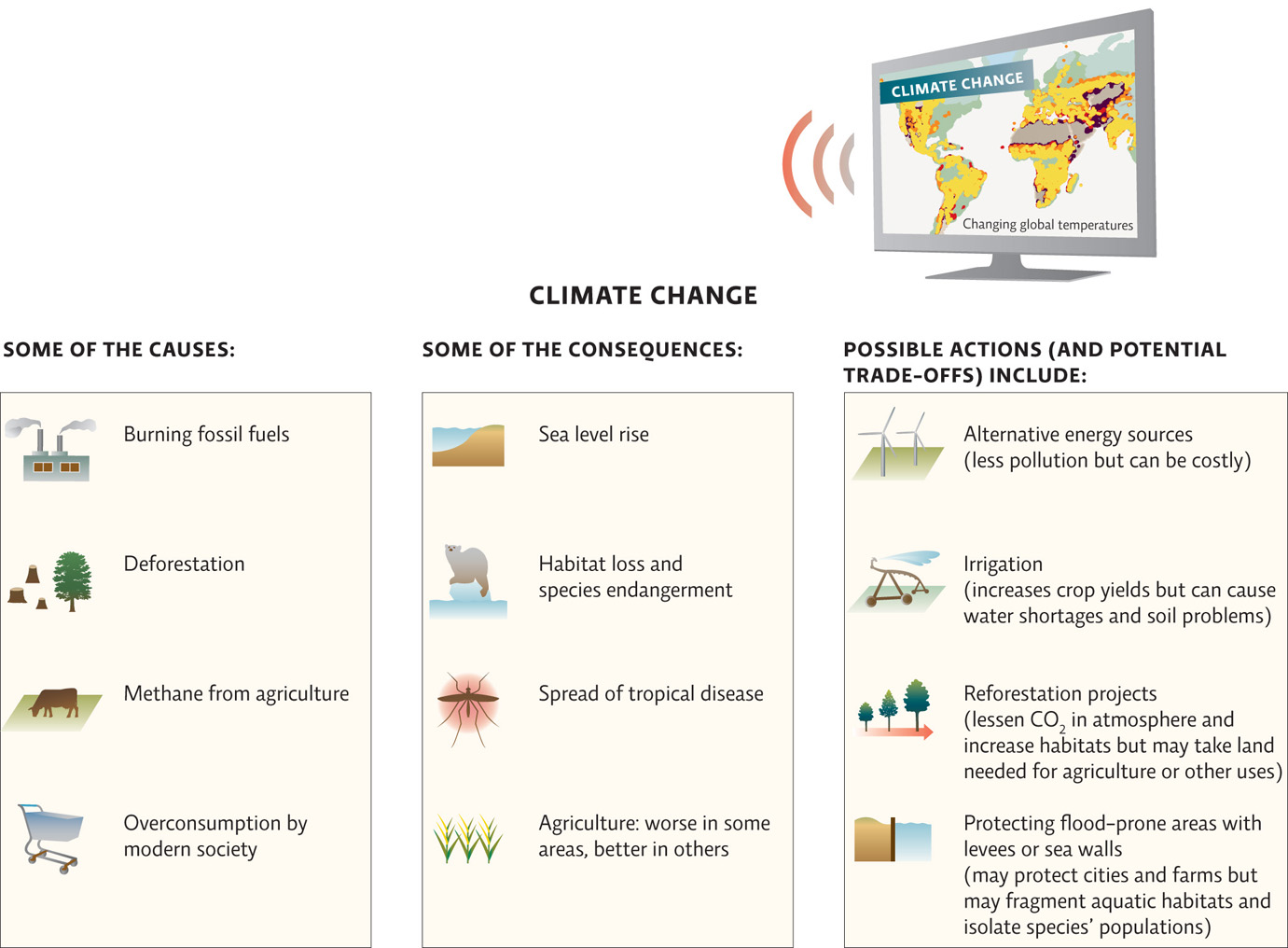Environmental science is all encompassing.
KEY CONCEPT 1.1
Environmental science draws from science and non-science disciplines to understand and address environmental problems.
From a modern developed society like the United States, it can be difficult to imagine a time and place when the natural world held such sway over our fate.
Our food comes from a grocery store, our water from a tap; even our air is artificially heated and cooled to our liking. These days, it seems more logical to consider societal conflict, or even collapse, through the lens of politics or economics. But, as we will see time and again throughout this book, the natural environment—and how we interact with it—plays a leading role in the sagas that shape human history; this is as true today as it was in the time of the Vikings.
Environment is a broad term that describes the surroundings or conditions (including living and nonliving components) in which any given organism exists. Environmental science—a field of research that is used to understand the natural world and our relationship to it—is extremely interdisciplinary. It relies on a range of natural and applied sciences (such as ecology, geology, chemistry, and engineering) to unlock the mystery of the natural world, and to look at the role and impact of humans in the world. It also draws on social sciences (such as anthropology, psychology, and economics) and the humanities (such as art, literature, and music) to understand the ways that humans interact with, and thus impact, the ecosystems around them. INFOGRAPHIC 1.1
environment
The biological and physical surroundings in which any given living organism exists.
environmental science
An interdisciplinary field of research that draws on the natural and social sciences and the humanities in order to understand the natural world and our relationship to it.
Environmental science studies the natural world and how humans interact with and impact it. We must look to the natural and social sciences as well as to the humanities to help us understand our world and effectively address environmental issues and environmental questions such as, “Why did the Vikings disappear from this region in Greenland, and how do humans live now in such a harsh environment?”

PETE RYAN/National Geographic Creative

How would you use your particular college major to help address an environmental problem?
Answers will vary but should be supported.
Environmental science is an empirical science: It scientifically investigates the natural world through systematic observation and experimentation. It is also an applied science: We use its findings to inform our actions and, in the best cases, to bring about positive change. INFOGRAPHIC 1.2
empirical science
A scientific approach that investigates the natural world through systematic observation and experimentation.
applied science
Research whose findings are used to help solve practical problems.
Environmental science is used to systematically collect and analyze data to draw conclusions and use these conclusions to propose reasonable courses of action.

Ashley Cooper/GHG/Aurora Photos
Verkis Consulting Engineers

If we don’t have an application in mind for an empirical research topic, is it worth pursuing?
Empirical research is worth pursing even without an application in mind for a variety of reasons: knowledge for its own sake (understanding our world); it could prove useful in the future, even if we don’t have an application in mind at the moment; the results of the research could reveal a useful application we had not considered.
The ability to understand environmental problems is referred to as environmental literacy. Such literacy is crucial to helping us become better stewards of Earth. Environmental problems can be extremely complicated and tend to have multiple causes, each one difficult to address. We must also understand that because of their complexity, any given response to an environmental problem involves significant trade-offs, and no one response is likely to present the ultimate solution. Scientists refer to such problems as “wicked problems.” In confronting them, we must consider not only their environmental but also their economic and social causes and consequences. Scientists refer to this trifecta as the triple bottom line. INFOGRAPHIC 1.3
environmental literacy
A basic understanding of how ecosystems function and of the impact of our choices on the environment.
trade-offs
The imperfect and sometimes problematic responses that we must at times choose between when addressing complex problems.
triple bottom line
The combination of the environmental, social, and economic impacts of our choices.
Wicked problems are difficult to address because, in many cases, each stakeholder hopes for a different solution. Solutions that address wicked problems usually involve trade-offs, so there is no clear “winner.” One example of a wicked problem is climate change. There are many causes of the current climate change we are experiencing, both natural and anthropogenic (caused by human actions), and the effects of climate change will be varied for different species and people, depending on where they live and their ability to adapt to the changes.


What are some other environmental “wicked problems” we face?
There are many wicked problems including: air and water pollution, feeding the world, meeting our energy needs sustainably; overpopulation; biodiversity loss; and many others.
KEY CONCEPT 1.2
Environmental problems are difficult to solve because there are multiple causes and consequences and because potential solutions come with trade-offs.
In his book Collapse, University of California at Los Angeles biologist Jared Diamond details how wicked problems can lead to a society’s ultimate demise. He identifies five factors in particular that determine whether any given society will succeed or fail: natural climate change, failure to properly respond to environmental changes, self-inflicted environmental damage, hostile neighbors, and loss of friendly neighbors. According to Diamond, the relative impact of each factor varies by society.
The situation of the Greenland Vikings was a rare case. It turns out that, as in a perfect storm, all five of these factors conspired together.